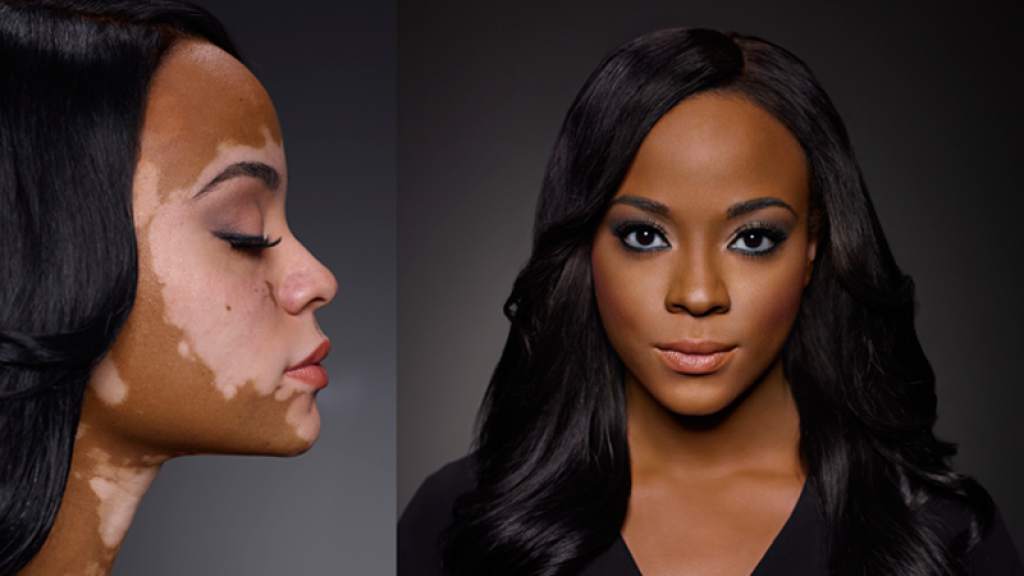CAUSES, SYMTOMS AND TREATMENT FOR VITILIGO SKIN DISORDER
Vitiligo Is A Skin Disorder That Causes The Skin To Lose Its Color.


Vitiligo is a skin disorder in which smooth white areas (called macules or patches) appear on a person’s skin. It generally starts on the hands, forearms, feet and face. Globally, about 1% or so of the population has vitiligo.
Table of Contents
What is vitiligo?
Vitiligo (vit-il-EYE-go) is a skin disorder that causes the skin to lose its color. Smooth white areas (called macules if less than 5mm or patches if 5mm or larger) appear on a person’s skin.
If you have vitiligo in a place that has hair, the hair on your body may also turn white.
The condition occurs when melanocytes (the skin cells that produce melanin, the chemical that gives skin its color, or pigmentation) are destroyed by the body’s immune system.
How does vitiligo spread?
Vitiligo usually begins with a few small white patches that may gradually spread over the body over the course of several months.
Vitiligo typically begins on the hands, forearms, feet, and face but can develop on any part of the body, including the mucous membranes (moist lining of the mouth, nose, genital, and rectal areas), the eyes, and inner ears.
Sometimes the larger patches continue to widen and spread, but usually they stay in the same place for years. The location of smaller molecules shifts and changes over time, as certain areas of skin lose and regain their pigments.
Vitiligo varies in the amount of skin affected, with some patients experiencing few depigmented areas and others with widespread loss of skin color.
Types of vitiligo
Vitiligo can be:
- Generalized, which is the most common type, when macules appear in various places on the body.
- Segmental, which is restricted to one side of the body or one area, such as the hands or face.
- Mucosal, which affects mucous membranes of the mouth and/or the genitals.
- Focal, which is a rare type in which the macules are in a small area and do not spread in a certain pattern within one to two years.
- Trichome, which means that there is a white or colorless center, then an area of lighter pigmentation, and then an area of normally colored skin.
- Universal, another rare type of vitiligo, and one in which more than 80% of the skin of the body lacks pigment.
How common is vitiligo?
Vitiligo occurs in about 1% or slightly more of the population throughout the world. Vitiligo affects all races and genders equally; however, it is more visible in people with darker skin.
Although vitiligo can develop in anyone at any age, it most commonly appears in people ages 10 to 30 years. Vitiligo rarely appears in the very young or very old.
What causes vitiligo?
Although the causes of vitiligo aren’t completely understood, there are a number of different theories:
- Autoimmune disorder: The affected person’s immune system may develop antibodies that destroy melanocytes.
- Genetic factors: Certain factors that may increase the chance of getting vitiligo can be inherited. About 30% of vitiligo cases run in families.
- Neurogenic factors: A substance that is toxic to melanocytes may be released at nerve endings in the skin.
- Self-destruction: A defect in the melanocytes causes them to destroy themselves.
Vitiligo may also be triggered by certain events, such as physical or emotional stress.
Because none of the explanations seem to completely account for the condition, it’s possible that a combination of these factors is responsible for vitiligo.
Is vitiligo painful?
Vitiligo is not painful. However, you can get painful sunburns on the lighter patches of skin.
It is important to protect yourself against the sun with measures like using sunscreen, staying out of the sun during the hours that it is strongest, and wearing protective clothing.
Some people with vitiligo have reported having itchy skin sometimes, including before the de-pigmentation starts.
Can I inherit vitiligo?
Vitiligo is not necessarily inherited. However, about 30% of people who have vitiligo do have at least one close relative who also has vitiligo.
Signs and symptoms of vitiligo
Signs and symptoms of vitiligo include the following:
- Patches of skin lose color. This can include the eyes and/or the mucous membranes in your mouth or nose.
- Patches of hair on your head or face turn prematurely gray or white.
What problems are associated with vitiligo?
Although vitiligo is mainly a cosmetic condition, people with vitiligo may experience a variety of problems:
- Because they lack melanocytes, macules are more sensitive to sunlight than the rest of the skin, so they will burn rather than tan.
- People with vitiligo may have some abnormalities in their retinas (the inner layer of the eye that contains light-sensitive cells) and some variation of color in their irises (the colored part of the eye). In some cases, there is some inflammation of the retina or iris, but vision is usually not affected.
- People with vitiligo may be more likely to get other autoimmune diseases (in which the body’s immune system causes it to attack itself), such as hypothyroidism, diabetes, pernicious anemia, Addison’s disease, and alopecia areata. Also, people with autoimmune diseases are more at risk for developing vitiligo.
- People with vitiligo may feel embarrassed or anxious about their skin. Sometimes people are rude – they may stare or say unkind things. This could cause a person with vitiligo to develop low self-esteem. This in turn could create anxiety or depression issues and make someone want to isolate. If this happens, you should talk to your healthcare provider or your family and friends to help you find a solution.
Treatment for vitiligo
Treatment for vitiligo is based on changing the appearance of the skin by restoring its color.
However, the effects of treatment are not usually permanent, and it cannot always control the spread of the condition.
A GP may recommend:
- sun safety
- a referral for camouflage creams
- a topical steroid (a cream or ointment that contains a steroid)
Further treatment may not be necessary if, for example, you only have a small patch of vitiligo or your natural skin color is very light.
You may be referred to a doctor who specializes in treating skin conditions (dermatologist) if further treatment is needed.
Protection from the sun
Sunburn is a severe risk if you have vitiligo. You must protect your skin from the sun and do not use sunbeds.
When skin is exposed to sunlight, it produces a pigment called melanin to help protect it from ultraviolet (UV) light. However, if you have vitiligo there is not enough melanin in your skin, so it is not protected.
Always apply a sunscreen, ideally with a sun protection factor (SPF) of 30 or above, to protect your skin from sunburn and long-term damage. This is particularly important if you have fair skin.
Vitamin D
If your skin is not exposed to the sun, there’s an increased risk of vitamin D deficiency. Vitamin D is essential for keeping bones and teeth healthy.
Sunlight is the main source of vitamin D, although a form of vitamin D is also found in some foods, such as oily fish.
It might be difficult to get enough vitamin D from food and sunlight alone. You should therefore consider taking a daily supplement containing 10 micro-grams (mcg) of vitamin D.
Skin camouflage
Skin camouflage creams can be applied to the white patches of skin. The creams are made to match your natural skin color.
The cream helps to blend the white patches with the rest of your skin, so they are not as noticeable.
For advice about skin camouflage, a GP may refer you to the Changing Faces Skin Camouflage Service.
You need to be trained in using the camouflage creams, but the service is free (although donations are welcome) and some creams can be prescribed on the NHS.
Camouflage creams are waterproof and can be applied anywhere on the body. They last for up to 4 days on the body and 12 to 18 hours on the face.
You can also get skin camouflage cream that contains sunscreen or has an SPF rating.
Topical steroids
They can sometimes stop the spread of the white patches and may restore some of your original skin color.
A topical steroid may be prescribed to adults if:
- you have non-segmental vitiligo on less than 10% of your body
- you want further treatment (sun protection and camouflage creams are enough for some people)
- you are not pregnant
- you understand and accept the risk of side effects
Speak to a GP if you want to use a topical steroid on your face.
Find out more about topical steroids.
Using topical steroids
A GP may prescribe a cream or an ointment, depending on what you prefer and where it will be used. Ointments are greasier. Creams are better in your joints – for example, inside your elbows.
Possible steroids that may be prescribed include:
- fluticasone propionate
- betamethasone valerate
- hydrocortisone butyrate
A GP will tell you how to apply the cream or ointment to the patches and how much you should use. You usually need to apply the treatment once a day.
Topical steroids are measured in a standard unit called the fingertip unit (FTU). One FTU is the amount of topical steroid squeezed along an adult’s fingertip. One FTU is enough to treat an area of skin twice the size of an adult’s hand.
Follow-up
After 1 month, you’ll have a follow-up appointment so the GP can check how well the treatment is working and whether you have any side effects.
If the treatment is causing side effects, you may need to stop using a topical steroid.
After another month or 2, the GP will check how much your vitiligo has improved. If there’s no improvement, you may be referred to a dermatologist.
If it’s improved slightly, you may continue treatment, but have a break from treatment every few weeks. You may also be referred to a dermatologist.
Treatment will be stopped if your vitiligo has improved significantly.
The GP may take photos of your vitiligo throughout your treatment to monitor any signs of improvement. You may also want to take photos yourself.
For any important information please contact us Email GadgetsNg info@gadgetsng.com
[Button id="1"]




I really like your writing style, fantastic information, thanks for posting : D.